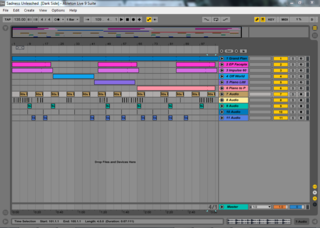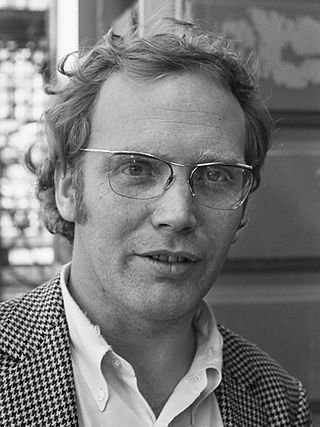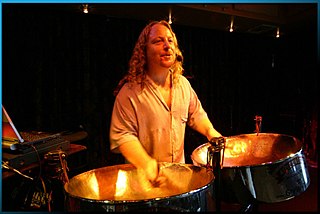
An electronic musical instrument or electrophone is a musical instrument that produces sound using electronic circuitry. Such an instrument sounds by outputting an electrical, electronic or digital audio signal that ultimately is plugged into a power amplifier which drives a loudspeaker, creating the sound heard by the performer and listener.

IRCAM is a French institute dedicated to the research of music and sound, especially in the fields of avant garde and electro-acoustical art music. It is situated next to, and is organisationally linked with, the Centre Pompidou in Paris. The extension of the building was designed by Renzo Piano and Richard Rogers. Much of the institute is located underground, beneath the fountain to the east of the buildings.
Nicolas Collins is a composer of mostly electronic music, a sound artist and writer. He received his BA and MA from Wesleyan University, and his PhD from the University of East Anglia. Upon graduating from Wesleyan, he was a Watson Fellow.
The Schreck Ensemble is a Dutch new music ensemble founded in 1989 by composers Arie van Schutterhoef and Hans van Eck. The name of the ensemble is a combination of the founders surnames and a reference to the actor Max Schreck. The Schreck Ensemble performs and commissions electroacoustic music. They also program their own software with the SuperCollider programming language, and develop their own hardware for the production and performance of electroacoustic music.

Ableton Live is a digital audio workstation for macOS and Windows developed by the German company Ableton. In contrast to many other software sequencers, Ableton Live is designed to be an instrument for live performances as well as a tool for composing, recording, arranging, mixing, and mastering. It is also used by DJs, as it offers a suite of controls for beatmatching, crossfading, and other different effects used by turntablists, and was one of the first music applications to automatically beatmatch songs. Live is available directly from Ableton in three editions: Intro, Standard, and Suite. Ableton also make a fourth version, Lite, with similar limitations to Intro. It is only available bundled with a range of music production hardware, including MIDI controllers and audio interfaces.
Nicholas Bullen is an English musician and a founding member of the grindcore band Napalm Death.
STEIM was a center for research and development of new musical instruments in the electronic performing arts, located in Amsterdam, Netherlands. Beginning in the 1970's, STEIM became known as a pioneering center for electronic music, where the specific context of electronic music was always strongly related to the physical and direct actions of a musician. In this tradition, STEIM supported artists in residence such as composers and performers, but also multimedia and video artists, helping them to develop setups which allowed for bespoke improvisation and performance with individually designed technology.

Peter Ane Schat was a Dutch composer.

Michel Waisvisz was a Dutch composer, performer and inventor of experimental electronic musical instruments. He was the artistic director of STEIM in Amsterdam from 1981, where he collaborated with musicians and artists from all over the world.

A backing track is an audio recording on audiotape, CD or a digital recording medium or a MIDI recording of synthesized instruments, sometimes of purely rhythmic accompaniment, often of a rhythm section or other accompaniment parts that live musicians play along with or sing along to. Backing tracks enable singers and bands to add parts to their music which would be impractical or impossible to perform live, such as string section or choir parts which were recorded in the studio. A backing track can be used by a one person band to add any amount of bass, drums and keyboards to their live shows without the cost of hiring extra musicians. A small pop group or rock band can use backing tracks to add a string section, horn section, drumming or backing vocals to their live shows.
John Stephen Richards is a British musician and composer working in the field of electronic music. Since 1999, he has predominantly explored performing with self-made instruments and creating interactive environments for composition.
Live electronic music is a form of music that can include traditional electronic sound-generating devices, modified electric musical instruments, hacked sound generating technologies, and computers. Initially the practice developed in reaction to sound-based composition for fixed media such as musique concrète, electronic music and early computer music. Musical improvisation often plays a large role in the performance of this music. The timbres of various sounds may be transformed extensively using devices such as amplifiers, filters, ring modulators and other forms of circuitry. Real-time generation and manipulation of audio using live coding is now commonplace.
Lindsay Vickery is an Australian composer and performer.
Solo for a melody instrument with feedback is a work for a soloist with live electronics composed in 1965–66 by Karlheinz Stockhausen. It is Nr. 19 in his catalogue of works. Performance duration can vary from 10½ to 19 minutes.
Henry Vega is a composer and Electroacoustic musician from New York City, currently living in The Hague, Netherlands. He founded The Spycollective in 2006, a now defunct music, theater and dance group, and is a founding director of Artek Foundation. Vega has been composing and performing internationally since 2001 and is also a founding member of The Electronic Hammer trio with Diego Espinosa and Juan Parra Cancino. He is married to Polish composer Kasia Glowicka.

Laetitia Sonami, is a sound artist, performer, and composer of interactive electronic music who has been based in the San Francisco Bay area since 1978. She is known for her electronic compositions and performances with the ‘’Lady’s Glove’’, an instrument she developed for triggering and manipulating sound in live performance. Many of her compositions include live or sampled text. Sonami also creates sound installation work incorporating household objects embedded with mechanical and electronic components. Although some recordings of her works exist, Sonami generally eschews releasing recorded work.
Franziska Baumann is a Swiss musician and composer, specializing in improvisation and composed music. Baumann studied at the Winterthur Conservatory, majoring in flute with a minor in singing. Following her conservatory studies, she completed improvisation classes with Fred Frith, Barre Phillips, and George Lewis. She also studied with vocal artists such as Phil Campanella, Lauren Newton, and Joan La Barbara. As a vocalist she makes use of extended and microtonal, with clicking and percussive sounds, tone changes and language-related techniques. Baumann performs solo and with musicians including Pierre Favre, Joëlle Léandre, Lê Quan Ninh, Jacques Demierre, Peter Schaerli, and Matthias Ziegler. She is also part of the improvisation trio, Potage du Jour, alongside Jürg Solothurnmann and Christoph Baumann. Her repertoire as a composer ranges from improvised works and electro-acoustic compositions to sound installations and large scale surround sound projects. As Artist in Residence at the Amsterdam Centre For Electro Instrumental Music (STEIM) Baumann programmed a data glove so that she could trigger voice and sound articulations in real time via gesture. Since 2006 Baumann has served as a lecturer in vocal performance and improvisation at the Hochschule der Künste in Bern, where she is also involved in research projects on topics such as sound without body and Gesture performance. Franziska Baumann lives and works in Bern, Switzerland.
Marko Ciciliani is a composer, audiovisual artist and performer.
Takuro Mizuta Lippit is a turn-tableist, curator and producer, who works in experimental electronic arts and improvised music.

The AudioCubes are a collection of wireless intelligent light emitting objects, capable of detecting each other's location and orientation, and user gestures, and were created by Bert Schiettecatte. They are an electronic musical instrument used by electronic musicians for live performance, sound design, music composition, and creating interactive applications in max/msp, pd and C++.







